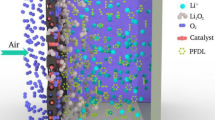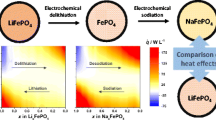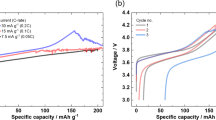Abstract
We present the characterization by the rotating-disc-electrode (RDE) and cyclic-voltammetry (CV) methods of oxygen-reduction/oxygen-evolution (ORR/OER) processes in the Na-air battery containing fresh and aged polyethylene glycol dimethyl ether 500 (PEGDME500)-based electrolyte. It was found that the time of storage of this solvent affects the oxidation overpotentials of the reduction products. It is suggested that the reason for the PEGDME500 change originates from the synthesis process, in which the sodium alcoholate molecule can remain in the solvent. Insertion of metallic sodium prevents aging of PEGDME500. The results are compared with a tetraethylene glycol dimethyl ether (TEGDME)-based electrolyte. It was shown that the voltammogram of the TEGDME-based electrolyte is similar to that of the fresh PEGDME500, but with the opposite ratio of NaO2-to-Na2O2 oxidation currents. This indicates that Na2O2 is the main reduction product in TEGDME, and we suggest that in fresh PEGDME500, Na2O2 is formed by the chemical disproportionation of the dissolved NaO2 in the solution.












Similar content being viewed by others
References
Review of International Policies for Vehicle Fuel Efficiency (2008) International Energy Agency. http://www.iea.org/publications/freepublications/publication/vehicle_fuel.pdf. Accessed 6 Aug 2017
World Energy Outlook (2007) International Energy Agency. http://www.worldenergyoutlook.org/media/weowebsite/2008-1994/WEO_2007.pdf. Accessed 6 Aug 2017
Kraytsberg A, Ein-Eli Y (2011) Review on Li–air batteries—opportunities, limitations and perspective. J Power Sources 196(3):886–893. https://doi.org/10.1016/j.jpowsour.2010.09.031
Balaish M, Kraytsberg A, Ein-Eli Y (2014) Realization of an artificial three-phase reaction zone in a Li–air battery. Chem Electro Chem 1(1):90–94. https://doi.org/10.1002/celc.201300055
Monaco S, Soavi F, Mastragostino M (2013) Role of oxygen mass transport in rechargeable Li/O2 batteries operating with ionic liquids. J Phys Chem Lett 4(9):1379–1382. https://doi.org/10.1021/jz4006256
Sharon D, Etacheri V, Garsuch A, Afri M, Frimer AA, Aurbach D (2013) On the challenge of electrolyte solutions for Li−air batteries: monitoring oxygen reduction and related reactions in polyether solutions by spectroscopy and EQCM. J Phys Chem Lett 4(1):127–131. https://doi.org/10.1021/jz3017842
Trahan MJ, Mukerjee S, Plichta EJ, Hendrickson MA, Abrahama KM (2013) Studies of Li-air cells utilizing dimethyl sulfoxide-based electrolyte. J Electrochem Soc 160:A259–A267
Das SK, Lau S, Archer LA (2014) Sodium–oxygen batteries: a new class of metal–air batteries. J Mater Chem A 2:2623–2629
Hartmann P, Bender CL, Vracar M, Dürr AK, Garsuch A, Janek J, Adelhelm P (2013) A rechargeable room-temperature sodium superoxide (NaO2) battery. Nat Mater 12(3):228–232. https://doi.org/10.1038/nmat3486
Yadegari H, Li Y, Mohammad YL, Banis MN, Li X, Wang B, Sun Q, Li R, Sham TK, Cui X, Sun X (2014) On rechargeability and reaction kinetics of sodium–air batteries. Energy Environ Sci 7:3747–3757
Bender CL, Hartmann P, Vracˇar M, Adelhelm P, Jane J (2014) On the thermodynamics, the role of the carbon cathode, and the cycle life of the sodium superoxide (NaO2) battery. Adv Energy Mater 4(12). https://doi.org/10.1002/aenm.201301863
Xia C, Black R, Fernandes R, Adams B, Nazar LF (2015) The critical role of phase-transfer catalysis in aprotic sodium oxygen batteries. Nat Chem 7(6):496–501. https://doi.org/10.1038/nchem.2260
Peled E, Golodnizky D, Mazor H, Goor M, Avshalomov S (2011) Parameter analysis of a practical lithium- and sodium-air electric vehicle battery. J Power Sources 196(16):6835–6840. https://doi.org/10.1016/j.jpowsour.2010.09.104
Peled E, Golodnitsky D, Hadar R, Mazor H, Goor M, Burstein L (2013) Challenges and obstacles in the development of sodium air batteries. J Power Sources 244:771–776. https://doi.org/10.1016/j.jpowsour.2013.01.177
Laoire CO, Mukerjee S, Abraham KM, Plichta EJ, Hendrickson MA (2010) Influence of nonaqueous solvents on the electrochemistry of oxygen in the rechargeable lithium-air battery. J Phys Chem C 114(19):9178–9186. https://doi.org/10.1021/jp102019y
Laoire CO, Mukerjee S, Abraham KM, Plichta EJ, Hendrickson MA (2009) Elucidating the mechanism of oxygen reduction for lithium–air battery applications. J Phys Chem C 113(46):20127–20134. https://doi.org/10.1021/jp908090s
De Giorgio F, Soavi F, Mastragostino M (2011) Effect of lithium ions on oxygen reduction in ionic liquid based electrolytes. Electrochem Commun 13(10):1090–1093. https://doi.org/10.1016/j.elecom.2011.07.004
Monacoa S, Arangioa AM, Soavi F, Mastragostino M, Paillard E, Passerini S (2012) An electrochemical study of oxygen reduction in pyrrolidinium based ionic liquids for lithium/oxygen batteries. Electrochim Acta 83:94–104. https://doi.org/10.1016/j.electacta.2012.08.001
Allen CJ, Hwang J, Kautz R, Mukerjee S, Plichta EJ, Hendrickson MA, Abraham KM (2012) Oxygen reduction reactions in ionic liquids and the formulation of a general ORR mechanism for Li−air batteries. J Phys Chem C 116(39):20755–20764. https://doi.org/10.1021/jp306718v
Ottakam Thotiyl MM, Freunberger SA, Peng Z, Bruce PG (2013) The carbon electrode in nonaqueous Li−O2 cells. J Am Chem Soc 135(1):494–500. https://doi.org/10.1021/ja310258x
Viswanathan V, Thygesen KS, Hummelshøj JS, Nørskov JK, Girishkumar G, McCloskey BD, Luntz AC (2011) Electrical conductivity in Li2O2 and its role in determining capacity limitations in non-aqueous Li-O2 batteries. J Chem Phys 135(21):214704. https://doi.org/10.1063/1.3663385
Weissermel K, Arpe HJ (1997) Industrial organic chemistry, 3rd edn. Wiley-VCH, Weinheim. https://doi.org/10.1002/9783527616688
Harris JM (1985) Laboratory synthesis of polyethylene glycol derivatives. J Macromol Sci Polymer Rev 25(3):325–373. https://doi.org/10.1080/07366578508081960
Johnson L, Li C, Liu Z, Chen Y, Freunberger SA, Ashok PC, Praveen BB, Dholakia K, Tarascon JM, Bruce PG (2014) The role of LiO2 solubility in O2 reduction in aprotic solvents and its consequences for Li-O2 batteries. Nat Chem 6(12):1091–1099. https://doi.org/10.1038/nchem.2101
Maercker A (1987) Ether cleavage with organo-alkali-metal compounds and alkali metals. Angew Chem Int Ed Engl 26(10):972–989. https://doi.org/10.1002/anie.198709721
Eisch JJ, Jacobs AM (1963) A convenient peparation of allyllithium. J Org Chem 28(8):2145–2146. https://doi.org/10.1021/jo01043a505
Gilman H, Schwebke GL (1962) Improved method for the preparation of benzyllithium. J Org Chem 27(12):4259–4261. https://doi.org/10.1021/jo01059a031
Freunberger SA, Chen Y, Drewerr NE, Hardwick LJ, Barde F, Bruce PG (2011) The lithium–oxygen battery with ether-based electrolytes. Angew Chem Int Ed 50(37):8609–8613. https://doi.org/10.1002/anie.201102357
Peled E (1979) The electrochemical behavior of alkali and alkaline earth metals in nonaqueous battery systems- the solid electrolyte interphase model. J Electrochem Soc 126(12):2047–2051. https://doi.org/10.1149/1.2128859
Acknowledgements
This research has been made with the financial support of ISF (INREP project).
Author information
Authors and Affiliations
Corresponding author
Rights and permissions
About this article
Cite this article
Faktorovich-Simon, E., Natan, A., Peled, E. et al. Oxygen redox processes in PEGDME-based electrolytes for the Na-air battery. J Solid State Electrochem 22, 1015–1022 (2018). https://doi.org/10.1007/s10008-017-3843-5
Received:
Revised:
Accepted:
Published:
Issue Date:
DOI: https://doi.org/10.1007/s10008-017-3843-5




